Canon EF 16-35mm f/2.8L III USM Review
-
Ease
of Use -
Sample
Images -
Lens
Specs -
Rating &
Conclusion -
Main
Rivals -
Review
Roundup - Comment
-
More…

Introduction
The EF 16-35mm f/4L IS USM is a new professional ultra-wide zoom lens for Canon's full-frame and APS-C DSLRs. Featuring an ultrasonic motor for smooth, precise and quiet continuous auto-focusing, a Subwavelength Coating and an Air Sphere Coating (ASC) on the lens elements to reduce flare and ghosting, and 9 rounded diaphragm blades for smoother bokeh, the weather-resistant Canon EF 24-105mm f/4L IS II USM is ideal for landscape or architecture photography. The Canon EF 16-35mm f/2.8L III USM is available now for £2349 / €2999 / $2199 in the UK, Europe and the USA respectively.
Ease of Use
For a professional L-series ultra-wide-angle zoom, the Canon EF 16-35mm f/2.8L III USM isn't too big and bulky considering the versatile focal range that it covers, weighing in at 790g and measuring nearly 13cm in length. While you can use it on a smaller APS-C body for a 24-52mm equivalent angle of view, it won't balance as well - as demonstrated by the images below, it's a much better match for a professional-grade, full-frame camera like the EOS 5D Mark IV.
 The Canon EF 16-35mm f/2.8L III USM lens mounted on a Canon EOS 5D Mark IV
The Canon EF 16-35mm f/2.8L III USM lens mounted on a Canon EOS 5D Mark IV
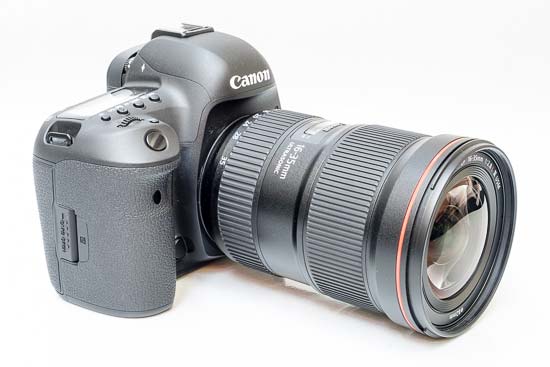 The Canon EF 16-35mm f/2.8L III USM lens mounted on a Canon EOS 5D Mark IV
The Canon EF 16-35mm f/2.8L III USM lens mounted on a Canon EOS 5D Mark IV
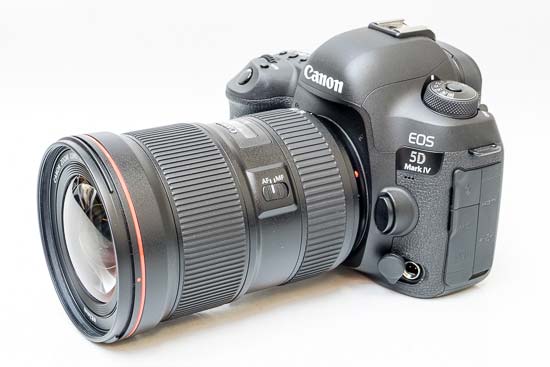 The Canon EF 16-35mm f/2.8L III USM lens mounted on a Canon EOS 5D Mark IV
The Canon EF 16-35mm f/2.8L III USM lens mounted on a Canon EOS 5D Mark IV
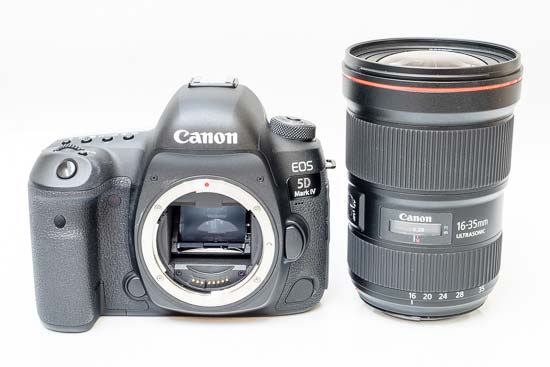 The Canon EF 16-35mm f/2.8L III USM lens alongisde the Canon EOS 5D Mark IV
The Canon EF 16-35mm f/2.8L III USM lens alongisde the Canon EOS 5D Mark IV
Build quality is excellent. The Canon EF 16-35mm f/2.8L III USM feels very solid in your hand, even if it is mostly made out of plastic, and it features enhanced resistance to shock and vibration and weather-proofing too. The focusing ring is generously wide, and has a ridged, rubberised grip band.
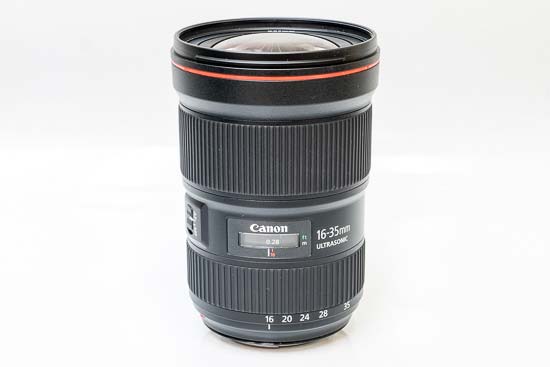 The side of the Canon EF 16-35mm f/2.8L III USM lens, set to 16mm
The side of the Canon EF 16-35mm f/2.8L III USM lens, set to 16mm
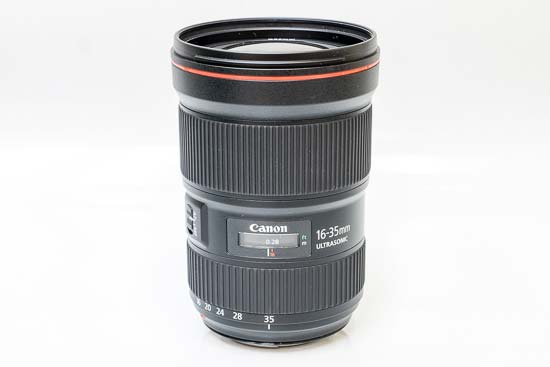 The side of the Canon EF 16-35mm f/2.8L III USM lens, set to 35mm
The side of the Canon EF 16-35mm f/2.8L III USM lens, set to 35mm
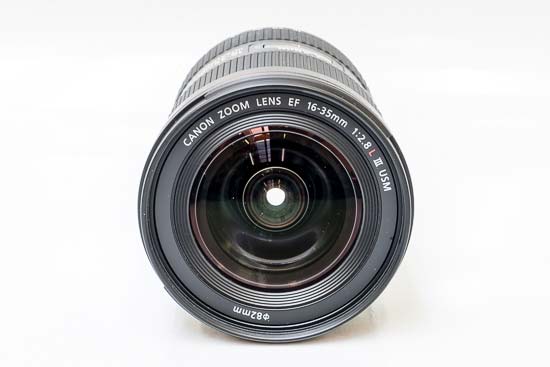 The front of the Canon EF 16-35mm f/2.8L III USM lens
The front of the Canon EF 16-35mm f/2.8L III USM lens
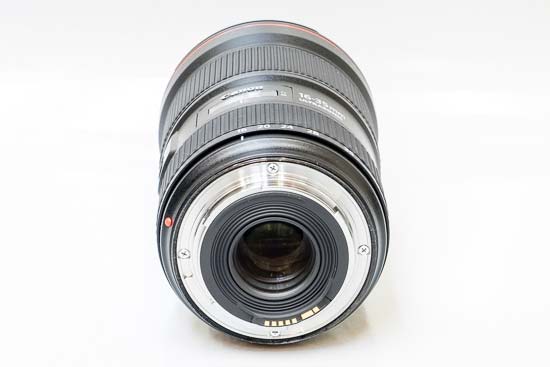 The rear of the Canon EF 16-35mm f/2.8L III USM lens
The rear of the Canon EF 16-35mm f/2.8L III USM lens
The final control on the lens barrel is a focus mode switch with the usual AF/MF settings. Note that the Canon EF 16-35mm f/2.8L III USM usefully offers full-time manual focusing even when AF is selected.
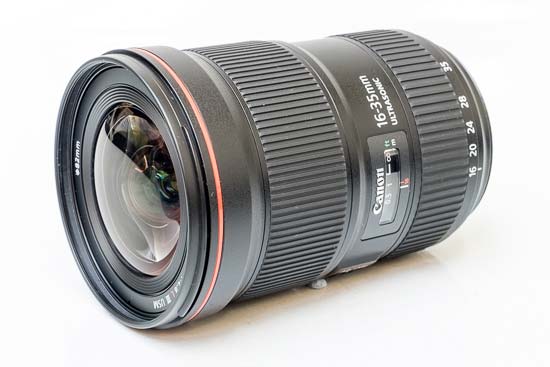 The side of the Canon EF 16-35mm f/2.8L III USM lens
The side of the Canon EF 16-35mm f/2.8L III USM lens
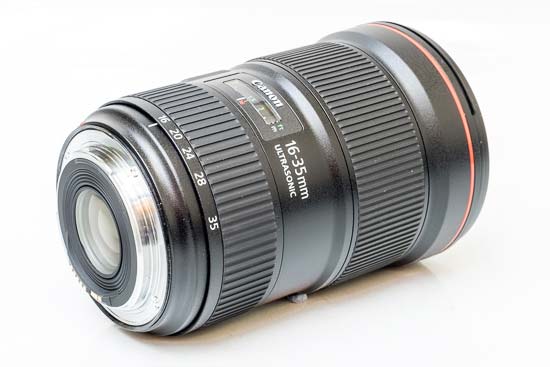 The side of the Canon EF 16-35mm f/2.8L III USM lens
The side of the Canon EF 16-35mm f/2.8L III USM lens
The Canon EF 16-35mm f/2.8L III USM lens ships with a slim petal-shaped lens hood (EW-88D) and a protective drawstring lens case.
 The Canon EF 16-35mm f/2.8L III USM lens in-hand
The Canon EF 16-35mm f/2.8L III USM lens in-hand
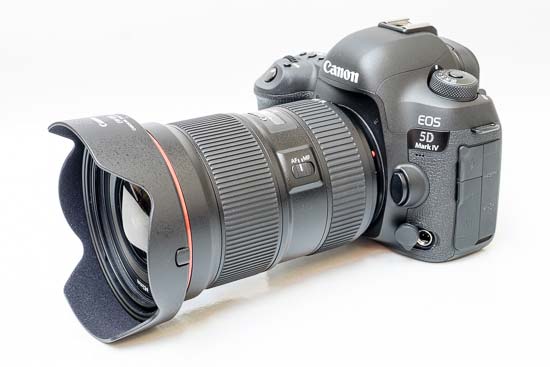 The Canon EF 16-35mm f/2.8L III USM lens with the supplied EW-88D lens hood fitted
The Canon EF 16-35mm f/2.8L III USM lens with the supplied EW-88D lens hood fitted
Focal Range
At the 16mm focal length the angle of view is 108°10' degrees.
 Field of view at 16mm
Field of view at 16mm
At the 35mm focal length the angle of view is 63 degrees.
 Field of view at 35mm
Field of view at 35mm
Focusing
The Canon EF 16-35mm f/2.8L III USM lens has a generously wide focus ring. There are hard stops at both ends of the range, making it easier to set focus at infinity. Polariser users should be pleased that the 82mm filter thread doesn't rotate on focus.
When it comes to auto-focusing, the Canon EF 16-35mm f/2.8L III USM zoom is a very quick performer, taking about 0.10 seconds to lock onto the subject when mounted on the Canon EOS 5D Mark IV that we tested it with.
We didn't experience much "hunting", either in good or bad light, with the lens accurately focusing almost all of the time. It's also a very quiet performer, thanks to the built-in USM (Ultra Sonic Motor), which makes this lens well-suited to video recording.
Chromatic Aberrations
Chromatic aberrations, typically seen as purple or blue fringes along contrasty edges, are impressively well controlled with this lens - the examples below show the worst-case scenario.
 |
 |
Vignetting and Distortion
With the lens wide open at f/2.8, you can see some obvious light fall-off in the corners at the 16mm focal length. Stopping down helps, although to completely get rid of this phenomenon, you will need to use an f-stop of f/8 or smaller.
Barrel distortion is evident at the 16mm wide-angle focal length, disappearing completely at 24mm, with some very slight pin-cushioning at 35mm.
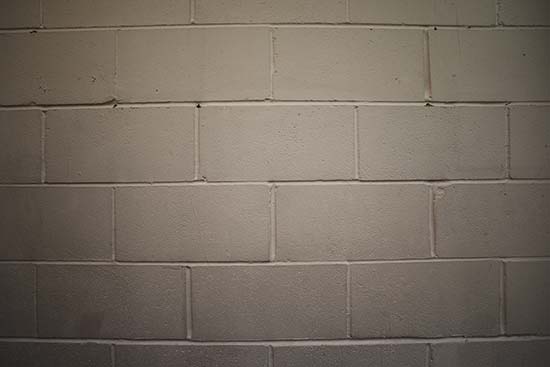 Vignetting at 16mm
Vignetting at 16mm
 Vignetting at 35mm
Vignetting at 35mm
Macro
The Canon EF 16-35mm f/2.8L III USM is not a macro lens. The close-focus point is at 28cm from the film/sensor plane, and Canon quotes a maximum reproduction ratio of 0.25x for the lens. The following example illustrates how close you can get to the subject at the 35mm focal length.
 Close-up performance
Close-up performance
Bokeh
Bokeh is a word used for the out-of-focus areas of a photograph, and is usually described in qualitative terms, such as smooth / creamy / harsh etc. Canon have employed an iris diaphragm with 9 rounded blades for a pleasing rendering of the out-of-focus highlights. Based on what we have seen, we can say that they largely succeeded. Below you'll find some examples, but you are also encouraged to check out our sample images.
 |
 |
 |
 |
Sharpness
In order to show you how sharp this lens is, we are providing 100% crops on the following pages.
-
Ease
of Use -
Sample
Images -
Lens
Specs -
Rating &
Conclusion -
Main
Rivals -
Review
Roundup - Comment
